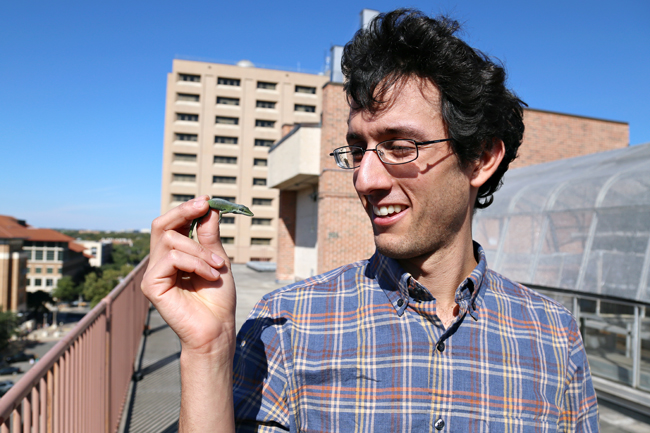As a child, Yoel Stuart played with snakes. Now as a postdoctoral researcher at UT, he plays with anole lizards as a scientist.
A recent study he worked on has received a lot of attention after his group published the paper in Science.
The study looked at one species of lizards, green anoles, living on islands off the coast of Florida and what happened after a different species of lizards, brown anoles, invaded. When forced to compete, evolutionary pressures forced the green anoles to develop larger and stickier toe pads for climbing trees.
Though evolution is often considered a slow process that takes hundreds of thousands of years, careful measurements allowed Stuart and his team to detect this change after only 15 years, or 20 generations of lizards, which is impressive when one considers just how subtle of a change this is. Green anoles are small animals — no more than 8 inches long, most of which is tail — and their toe pads only increased in size by about 4 percent to 6 percent over this time.
It’s not just later-generation lizards growing larger toes, though. Stuart and his team concluded that this was the result of evolutionary adaptation.
“I think the reason we can say that so confidently is that we ruled out all the other possibilities,” Stuart said.
For instance, another possible explanation could be that the toe pad size and stickiness weren’t coded into the lizards’ genes but were the result of the environment. The feet of a tribe of barefoot-running humans will look very different than those of street-walking Austinites, and it has nothing to do with genetics.
Stuart and his co-authors took green anole eggs from several different islands and raised them in identical conditions. The anole hatchlings from the invaded islands grew larger and stickier toes than those that weren’t, strongly suggesting this was a genetic change.
The team also performed genetic analysis of different species of green anoles from separate islands to make sure that larger-toed green anoles hadn’t migrated to the islands during the 15-year study and created the illusion of adaptation.
The different islands all had lizard populations about equally distinct from each other genetically, suggesting that the larger-toed lizards on the different islands evolved independently.
A further analysis showed that the island populations themselves were all about equally diverse, which wouldn’t happen if larger-toed lizards migrated to certain areas and added their genes to the pool.
The anoles from the invaded islands do tend to climb higher than those from the non-invaded ones, and there are other studies that show that these traits do correspond to better climbers in many other lizard species, but one can never be too sure. A hypothesis is only as strong as the tests it’s subjected to, and, if Stuart and his colleagues are correct, then further tests will only increase their confidence.
Of course, follow-up studies are also a good excuse to spend more time with the green anoles.
“They’re just neat creatures,” Stuart said. “They’re fun to observe and catch and hang out with.”















